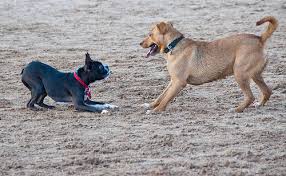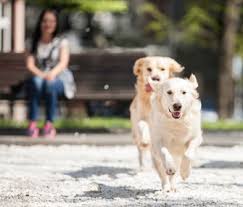NOTE: This is the third in a series of articles about how to maximize your dog’s experience at the dog park. In this article we will discuss what is expected of you at the dog park and how to remain in control.

You have made sure your dog is ready by following the tips provided in the first article of this series, 4 Steps You Must Take BEFORE Bringing Your Dog To The Dog Park. So, you have chosen which dog park to attend by reading, What Makes A Dog Park Right for YOUR Dog?, but NOW WHAT?
Here’s what to do at the park to ensure the visit is a wonderful addition to you and your dog’s day:
Consider What To Bring
- Leave most of your dog’s favorite treats and toys at home. Food and toys, especially ones your dog feels possessive about, can cause problems at dog parks. You may, however, want to keep one of your dog’s all-time favorite treat and/or a special toy that your dog always reacts favorably to hidden in your pocket. Should your dog not want to leave the dog park or if they become fixated on someone or something, that one item could be used to regain your dog’s attention.
- Even though most parks have poop bag stations for your convenience, you should bring your own waste bags. The stress and excitement of the park can cause dogs to “go” more than usual and you should come prepared to help keep the park clean.
- Most parks have a water source for your dog to drink from, but you can never be too prepared. It is best to carry water with you in case your dog is picky or possessive or just wanders away from the water source. There are many options with portable bowls included. We like The Gulpy the best.
- It’s hard to pay close attention to more than one dog at the park. So if you have multiple dogs, bring them separately, letting each one take individual turns at the park.
- It is NOT recommended to take kids to dog parks. They can be a distraction and add another variable of uncertainty to the mix. You never know how a dog will react to a child or how a child will react to a dog.

When You Arrive
- When approaching the entrance, stay clear of other dogs on-leash entering or leaving the park. Give on leash dogs space to avoid any leash aggression issues and allow other dogs to enter the park solo.
- Before entering, make sure the perimeter of the dog park is secured. Gates can be left unlatched by mistake or the fencing may be damaged.
- Once inside the first of the double gates, assuming your park has this feature, unclip your dog’s leash so there is no mix of leashed and unleashed dogs inside the park. Beyond your dog’s collar, consider removing additional halters or clothing that could get caught in another dog’s mouth during play.
 Once Inside The Park
Once Inside The Park
- All your attention should be focused on your dog and their interactions. Resist the urge to text or talk on your phone — in fact, just put it away.
- Watch your dog’s body language to make sure they are having fun. If they are cowering, licking and panting more than usual or their hackles are raised you need to remove your dog from the situation immediately. Signs of stress or aggression should be taken seriously and need to be noticed and acted upon before the escalate.
- Pick up after your dog and dispose of it properly.
- Make sure your dog has access to water at least every 30 minutes, more often if it is hot.
- Be friendly with the other dog owners at the park. If needed, they can help you enforce boundaries between the dogs and can help you determine what is normal behavior for the park.
- Avoid Staying in one spot. Dogs are territorial, especially when in a group. If you keep them moving at the park, then they don’t have a territory to protect.
- Leave the park at the first sign of conflict. This prevents the conflict from escalating and, if your dog was the culprit, sends a message that the behavior is not allowed.
Dog parks are a great opportunity for your pup to interact and play with other dogs. With forethought and attentiveness, you and your dog can avoid unnecessary confrontations and take advantage of everything dog parks have to offer.




Leave a Reply